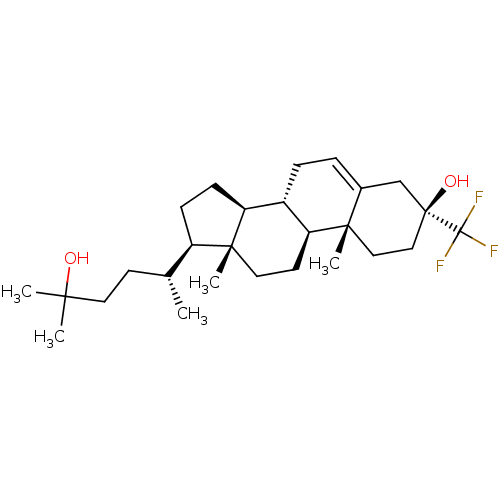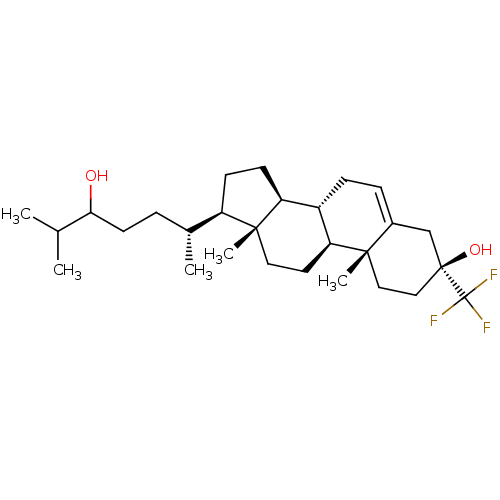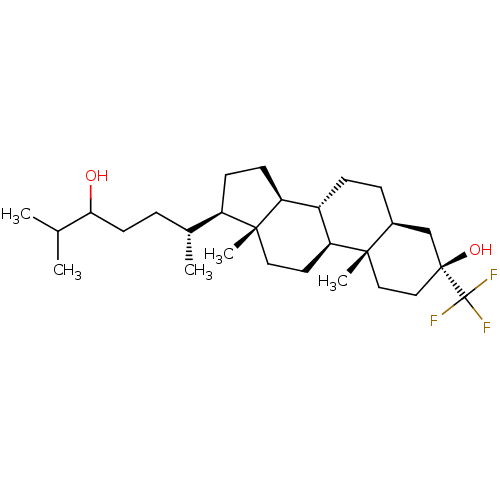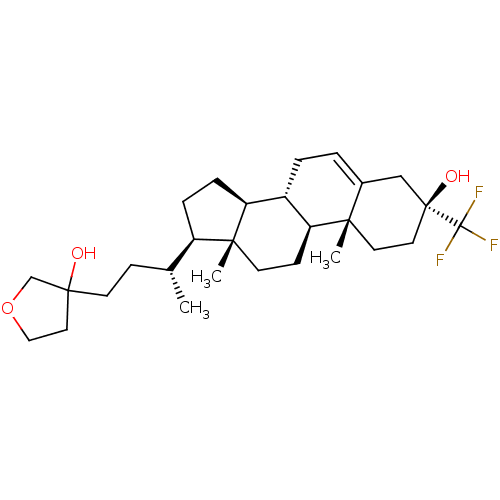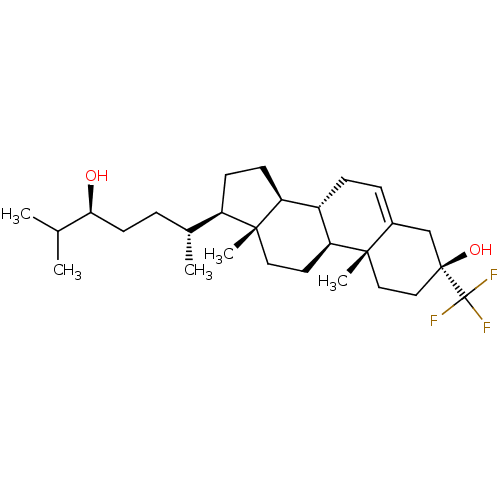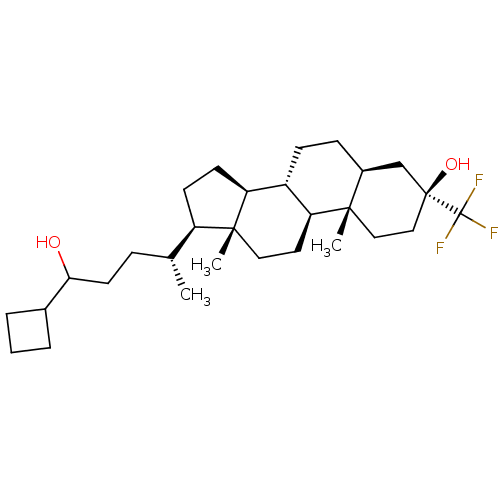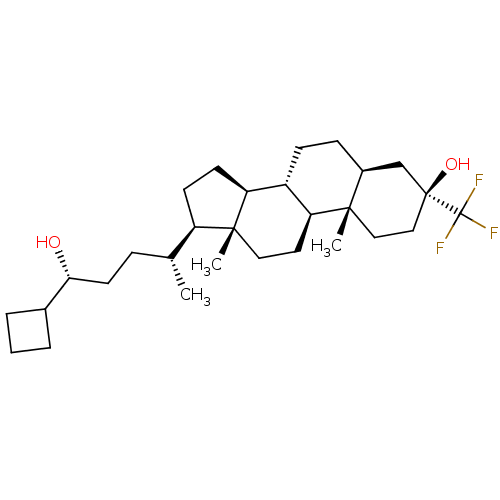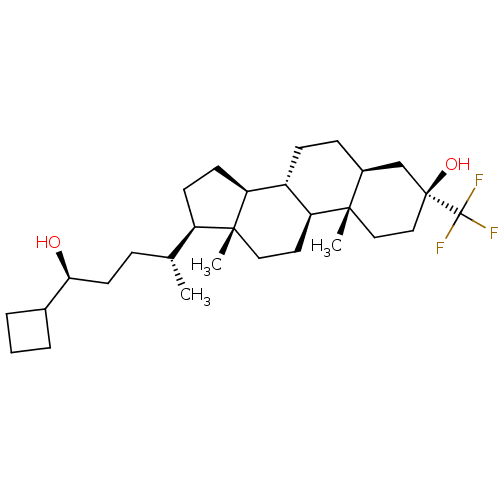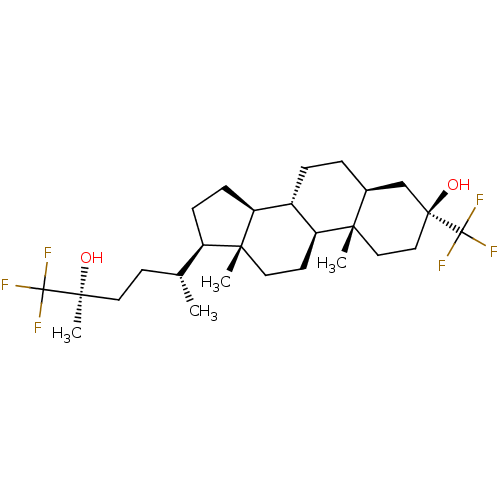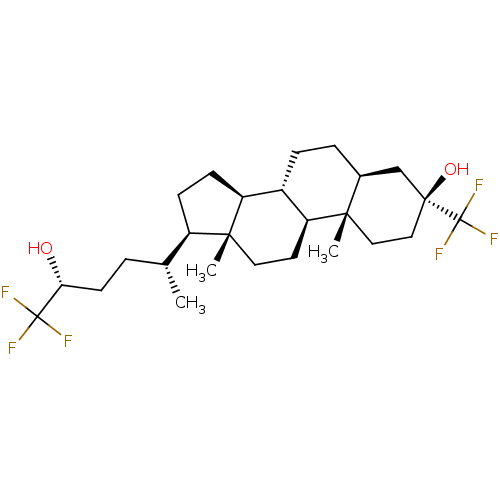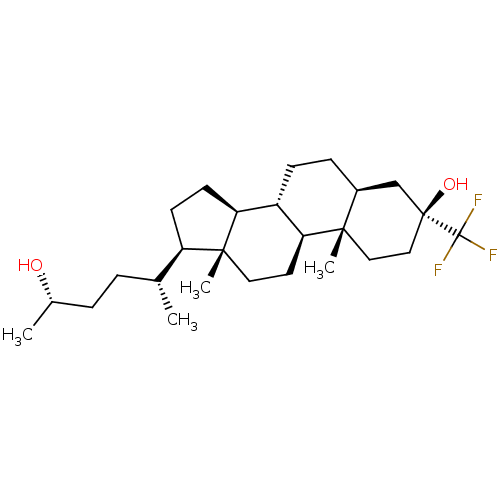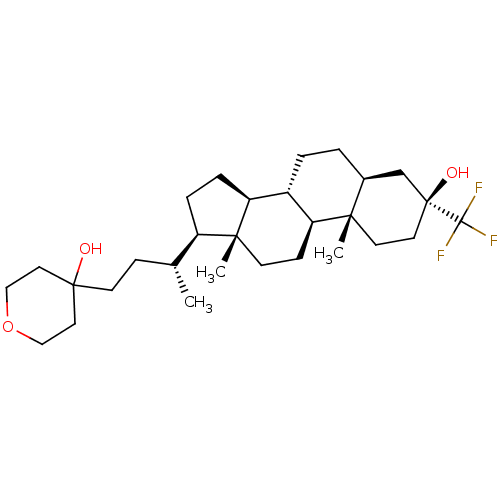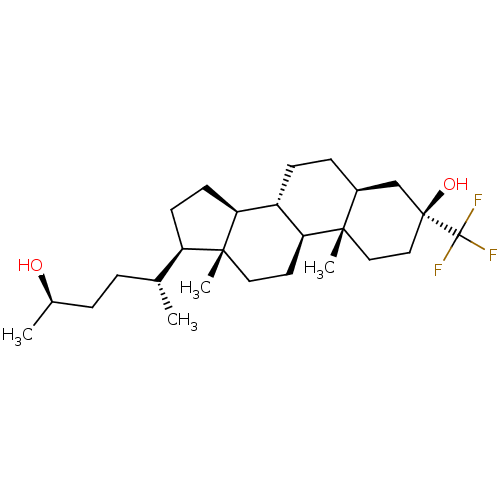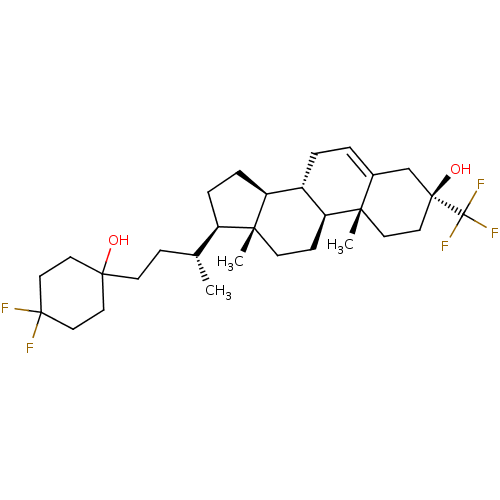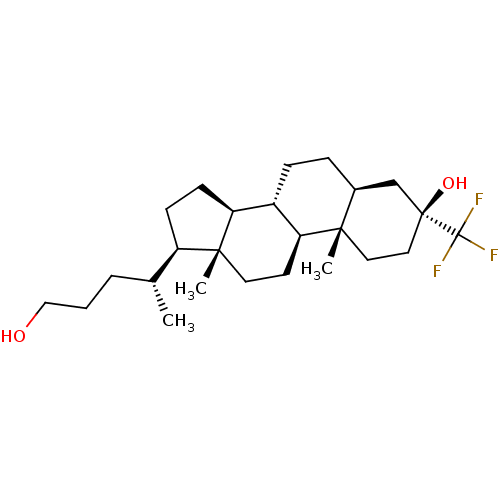Report error Found 314 Enz. Inhib. hit(s) with all data for entry = 10229
Affinity DataEC50: 295nMAssay Description:The whole-cell patch-clamp technique was used to investigate the effects of positive allosteric modulating activity of test compounds on GlunN1/GluN2...More data for this Ligand-Target Pair
Affinity DataEC50: 148nMAssay Description:The whole-cell patch-clamp technique was used to investigate the effects of positive allosteric modulating activity of test compounds on GlunN1/GluN2...More data for this Ligand-Target Pair
Affinity DataEC50: 145nMAssay Description:The whole-cell patch-clamp technique was used to investigate the effects of positive allosteric modulating activity of test compounds on GlunN1/GluN2...More data for this Ligand-Target Pair
Affinity DataEC50: 70.9nMAssay Description:The whole-cell patch-clamp technique was used to investigate the effects of positive allosteric modulating activity of test compounds on GlunN1/GluN2...More data for this Ligand-Target Pair
Affinity DataEC50: 163nMAssay Description:The whole-cell patch-clamp technique was used to investigate the effects of positive allosteric modulating activity of test compounds on GlunN1/GluN2...More data for this Ligand-Target Pair
Affinity DataEC50: 147nMAssay Description:The whole-cell patch-clamp technique was used to investigate the effects of positive allosteric modulating activity of test compounds on GlunN1/GluN2...More data for this Ligand-Target Pair
Affinity DataEC50: 158nMAssay Description:The whole-cell patch-clamp technique was used to investigate the effects of positive allosteric modulating activity of test compounds on GlunN1/GluN2...More data for this Ligand-Target Pair
Affinity DataEC50: 339nMAssay Description:The whole-cell patch-clamp technique was used to investigate the effects of positive allosteric modulating activity of test compounds on GlunN1/GluN2...More data for this Ligand-Target Pair
Affinity DataEC50: 131nMAssay Description:The whole-cell patch-clamp technique was used to investigate the effects of positive allosteric modulating activity of test compounds on GlunN1/GluN2...More data for this Ligand-Target Pair
Affinity DataEC50: 143nMAssay Description:The whole-cell patch-clamp technique was used to investigate the effects of positive allosteric modulating activity of test compounds on GlunN1/GluN2...More data for this Ligand-Target Pair
Affinity DataEC50: 125nMAssay Description:The whole-cell patch-clamp technique was used to investigate the effects of positive allosteric modulating activity of test compounds on GlunN1/GluN2...More data for this Ligand-Target Pair
Affinity DataEC50: 102nMAssay Description:The whole-cell patch-clamp technique was used to investigate the effects of positive allosteric modulating activity of test compounds on GlunN1/GluN2...More data for this Ligand-Target Pair
Affinity DataEC50: 109nMAssay Description:The whole-cell patch-clamp technique was used to investigate the effects of positive allosteric modulating activity of test compounds on GlunN1/GluN2...More data for this Ligand-Target Pair
Affinity DataEC50: 81.2nMAssay Description:The whole-cell patch-clamp technique was used to investigate the effects of positive allosteric modulating activity of test compounds on GlunN1/GluN2...More data for this Ligand-Target Pair
Affinity DataEC50: 31.6nMAssay Description:The whole-cell patch-clamp technique was used to investigate the effects of positive allosteric modulating activity of test compounds on GlunN1/GluN2...More data for this Ligand-Target Pair
Affinity DataEC50: 33.6nMAssay Description:The whole-cell patch-clamp technique was used to investigate the effects of positive allosteric modulating activity of test compounds on GlunN1/GluN2...More data for this Ligand-Target Pair
Affinity DataEC50: 300nMAssay Description:The whole-cell patch-clamp technique was used to investigate the effects of positive allosteric modulating activity of test compounds on GlunN1/GluN2...More data for this Ligand-Target Pair
Affinity DataEC50: 287nMAssay Description:The whole-cell patch-clamp technique was used to investigate the effects of positive allosteric modulating activity of test compounds on GlunN1/GluN2...More data for this Ligand-Target Pair
Affinity DataEC50: 317nMAssay Description:The whole-cell patch-clamp technique was used to investigate the effects of positive allosteric modulating activity of test compounds on GlunN1/GluN2...More data for this Ligand-Target Pair
Affinity DataEC50: 234nMAssay Description:The whole-cell patch-clamp technique was used to investigate the effects of positive allosteric modulating activity of test compounds on GlunN1/GluN2...More data for this Ligand-Target Pair
Affinity DataEC50: 185nMAssay Description:The whole-cell patch-clamp technique was used to investigate the effects of positive allosteric modulating activity of test compounds on GlunN1/GluN2...More data for this Ligand-Target Pair
Affinity DataEC50: 338nMAssay Description:The whole-cell patch-clamp technique was used to investigate the effects of positive allosteric modulating activity of test compounds on GlunN1/GluN2...More data for this Ligand-Target Pair
Affinity DataEC50: 171nMAssay Description:The whole-cell patch-clamp technique was used to investigate the effects of positive allosteric modulating activity of test compounds on GlunN1/GluN2...More data for this Ligand-Target Pair
Affinity DataEC50: 113nMAssay Description:The whole-cell patch-clamp technique was used to investigate the effects of positive allosteric modulating activity of test compounds on GlunN1/GluN2...More data for this Ligand-Target Pair
Affinity DataEC50: 347nMAssay Description:The whole-cell patch-clamp technique was used to investigate the effects of positive allosteric modulating activity of test compounds on GlunN1/GluN2...More data for this Ligand-Target Pair
Affinity DataEC50: 306nMAssay Description:The whole-cell patch-clamp technique was used to investigate the effects of positive allosteric modulating activity of test compounds on GlunN1/GluN2...More data for this Ligand-Target Pair
Affinity DataEC50: 248nMAssay Description:The whole-cell patch-clamp technique was used to investigate the effects of positive allosteric modulating activity of test compounds on GlunN1/GluN2...More data for this Ligand-Target Pair
Affinity DataEC50: 187nMAssay Description:The whole-cell patch-clamp technique was used to investigate the effects of positive allosteric modulating activity of test compounds on GlunN1/GluN2...More data for this Ligand-Target Pair
Affinity DataEC50: 446nMAssay Description:The whole-cell patch-clamp technique was used to investigate the effects of positive allosteric modulating activity of test compounds on GlunN1/GluN2...More data for this Ligand-Target Pair
Affinity DataEC50: 372nMAssay Description:The whole-cell patch-clamp technique was used to investigate the effects of positive allosteric modulating activity of test compounds on GlunN1/GluN2...More data for this Ligand-Target Pair
Affinity DataEC50: 201nMAssay Description:The whole-cell patch-clamp technique was used to investigate the effects of positive allosteric modulating activity of test compounds on GlunN1/GluN2...More data for this Ligand-Target Pair
Affinity DataEC50: 212nMAssay Description:The whole-cell patch-clamp technique was used to investigate the effects of positive allosteric modulating activity of test compounds on GlunN1/GluN2...More data for this Ligand-Target Pair
Affinity DataEC50: 182nMAssay Description:The whole-cell patch-clamp technique was used to investigate the effects of positive allosteric modulating activity of test compounds on GlunN1/GluN2...More data for this Ligand-Target Pair
Affinity DataEC50: 260nMAssay Description:The whole-cell patch-clamp technique was used to investigate the effects of positive allosteric modulating activity of test compounds on GlunN1/GluN2...More data for this Ligand-Target Pair
Affinity DataEC50: 248nMAssay Description:The whole-cell patch-clamp technique was used to investigate the effects of positive allosteric modulating activity of test compounds on GlunN1/GluN2...More data for this Ligand-Target Pair
Affinity DataEC50: 733nMAssay Description:The whole-cell patch-clamp technique was used to investigate the effects of positive allosteric modulating activity of test compounds on GlunN1/GluN2...More data for this Ligand-Target Pair
Affinity DataEC50: 117nMAssay Description:The whole-cell patch-clamp technique was used to investigate the effects of positive allosteric modulating activity of test compounds on GlunN1/GluN2...More data for this Ligand-Target Pair
Affinity DataEC50: 104nMAssay Description:The whole-cell patch-clamp technique was used to investigate the effects of positive allosteric modulating activity of test compounds on GlunN1/GluN2...More data for this Ligand-Target Pair
Affinity DataEC50: 165nMAssay Description:The whole-cell patch-clamp technique was used to investigate the effects of positive allosteric modulating activity of test compounds on GlunN1/GluN2...More data for this Ligand-Target Pair
Affinity DataEC50: 187nMAssay Description:The whole-cell patch-clamp technique was used to investigate the effects of positive allosteric modulating activity of test compounds on GlunN1/GluN2...More data for this Ligand-Target Pair
Affinity DataEC50: 129nMAssay Description:The whole-cell patch-clamp technique was used to investigate the effects of positive allosteric modulating activity of test compounds on GlunN1/GluN2...More data for this Ligand-Target Pair
Affinity DataEC50: 175nMAssay Description:The whole-cell patch-clamp technique was used to investigate the effects of positive allosteric modulating activity of test compounds on GlunN1/GluN2...More data for this Ligand-Target Pair
Affinity DataEC50: 65.8nMAssay Description:The whole-cell patch-clamp technique was used to investigate the effects of positive allosteric modulating activity of test compounds on GlunN1/GluN2...More data for this Ligand-Target Pair
Affinity DataEC50: 80nMAssay Description:The whole-cell patch-clamp technique was used to investigate the effects of positive allosteric modulating activity of test compounds on GlunN1/GluN2...More data for this Ligand-Target Pair
Affinity DataEC50: 764nMAssay Description:The whole-cell patch-clamp technique was used to investigate the effects of positive allosteric modulating activity of test compounds on GlunN1/GluN2...More data for this Ligand-Target Pair
Affinity DataEC50: 494nMAssay Description:The whole-cell patch-clamp technique was used to investigate the effects of positive allosteric modulating activity of test compounds on GlunN1/GluN2...More data for this Ligand-Target Pair
Affinity DataEC50: 104nMAssay Description:The whole-cell patch-clamp technique was used to investigate the effects of positive allosteric modulating activity of test compounds on GlunN1/GluN2...More data for this Ligand-Target Pair
Affinity DataEC50: 47.5nMAssay Description:The whole-cell patch-clamp technique was used to investigate the effects of positive allosteric modulating activity of test compounds on GlunN1/GluN2...More data for this Ligand-Target Pair
Affinity DataEC50: 768nMAssay Description:The whole-cell patch-clamp technique was used to investigate the effects of positive allosteric modulating activity of test compounds on GlunN1/GluN2...More data for this Ligand-Target Pair
Affinity DataEC50: 751nMAssay Description:The whole-cell patch-clamp technique was used to investigate the effects of positive allosteric modulating activity of test compounds on GlunN1/GluN2...More data for this Ligand-Target Pair
